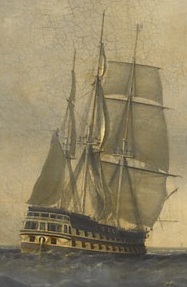HMS Edinburgh (1811) facts for kids

Edinburgh, by John Lynn
|
|
Quick facts for kids History |
|
|---|---|
| Name | HMS Edinburgh |
| Ordered | 13 July 1807 |
| Builder | Brent, Rotherhithe |
| Laid down | November 1807 |
| Launched | 26 November 1811 |
| Fate | Sold, 1866 |
| General characteristics | |
| Class and type | Vengeur-class ship of the line |
| Tons burthen | 1772 bm |
| Length | 176 ft (54 m) (gundeck) |
| Beam | 47 ft 6 in (14.48 m) |
| Depth of hold | 21 ft (6.4 m) |
| Propulsion | Sails |
| Sail plan | Full-rigged ship |
| Armament |
|
HMS Edinburgh was a large sailing warship of the Royal Navy. It was a "74-gun third rate ship of the line," meaning it carried 74 cannons and was a powerful type of warship at the time. The ship was launched on November 26, 1811, in Rotherhithe, a place in London.
Contents
The HMS Edinburgh had an interesting and busy life serving the British Navy. It sailed to different parts of the world and was even changed to use new technology.
Early Years and Mediterranean Service
From 1837 to 1841, HMS Edinburgh was part of the British fleet in the Mediterranean Sea. During this time, it helped in a conflict called the Syrian War. The ship operated off the coasts of Syria and Lebanon, supporting British interests in the region.
A Big Change: Steam Power!
In 1846, the Edinburgh went into Portsmouth Dockyard for a major upgrade. It was converted to use a new type of power: steam! This meant it could now move with a screw propeller as well as its sails.
Becoming a Blockship
After its conversion, the Edinburgh became known as a 'blockship'. These were older warships that were updated with steam engines. They were often used to guard important ports. The conversion was finished on August 19, 1852. With these changes, the ship became heavier and its number of guns was reduced to about 60.
Service in the Baltic Sea
In February 1854, HMS Edinburgh was sent to the Baltic Sea. It joined a large fleet led by Sir Charles John Napier. This was during the Crimean War, a big conflict involving several European powers.
Flagship at Bomarsund
The Edinburgh was a very important ship in the Baltic fleet. It was the flagship for Rear-Admiral Henry Ducie Chads. This means it was the ship where the admiral lived and directed his part of the fleet. The Edinburgh played a key role in attacking and capturing the Russian fortress of Bomarsund on the Åland islands. It returned to the Baltic again in 1855.
Later Duty and Retirement
After its time in the Baltic, the Edinburgh served as a guard ship in other important naval bases. It was stationed at Sheerness and later at Leith. Finally, in 1866, the ship was sold by the Navy to be taken apart. This marked the end of its long service.

